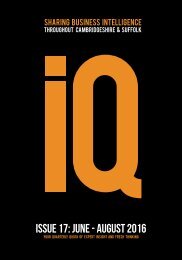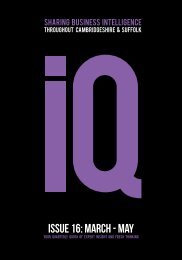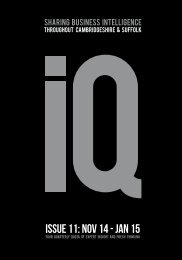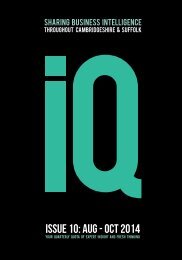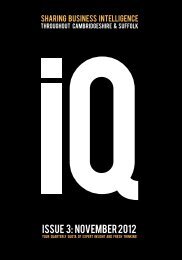IQ-Magazine-Issue-15
Create successful ePaper yourself
Turn your PDF publications into a flip-book with our unique Google optimized e-Paper software.
<strong>IQ</strong> human resources<br />
Jacqui Kemp of Namasté Culture which helps businesses to create positive working environments,<br />
offers some insights into how body language can be interpreted in the work place.<br />
In the last issue, I spoke about the research of Albert<br />
Mehrabian, identifying that when discussing our attitudes<br />
or feelings we receive 55% of the message from non-verbal<br />
clues e.g. body language, and how our own body language<br />
can affect the way we respond to email.<br />
By ensuring our body language is congruent with the words<br />
we use, we will give a clear message. If however, I say yes to<br />
something while shaking my head, the other person may not<br />
be convinced that I mean what I have said.<br />
When you are in a situation where you don’t necessarily<br />
believe the words that you are hearing, you may have<br />
unconsciously picked up some clues from the other person's<br />
body language.<br />
The non-verbal clues we give include:<br />
• Overall posture<br />
• Facial expressions<br />
• Head and hand movements<br />
• Tone of voice<br />
• Eye contact - recent research suggests that we may<br />
hold eye contact for longer when telling untruths to try<br />
to appear sincere<br />
Rapport occurs when two or more people feel they are in<br />
sync or on the same wavelength because they feel similar or<br />
relate well to each other.<br />
When we are in a disagreement with someone else, we may<br />
close down our body language by folding our arms, turning<br />
our body away from them and giving generally discouraging<br />
signals.<br />
When we have good rapport, we will naturally mirror the<br />
other person, nod our head to what they are saying, match<br />
the language they use and generally give encouraging signals<br />
to show we are in agreement.<br />
We can use this natural mirroring to build rapport with<br />
someone we may disagree with.<br />
Sometimes I ask people to discuss something they disagree<br />
on and match body language. It sounds counter intuitive, but<br />
I have found that people start listening to the other person's<br />
perspective when they do not allow themselves to physically<br />
shut the other person out.<br />
I have witnessed people who have had long-standing conflict<br />
find agreement when using this simple technique; they may<br />
never be best friends, but they can start to find some common<br />
ground.<br />
It can be fun to practice picking up the signals by watching<br />
others, perhaps by watching interviews on TV, or if there<br />
is something that you tend to disagree on at home. Try<br />
matching the other person's body language (before things get<br />
heated) and see what the outcome is!<br />
More Information<br />
01954 267640<br />
www.namasteculture.co.uk<br />
issue <strong>15</strong> | page 27







